NCERT Class 6 Science Chapter 2 Sorting Materials Into Groups Long Question And Answers
Question 1. Chalk, iron nails, wood, aluminium, candles, and cotton usually look different from each other. Give some properties by which we can prove that these materials are different.
Answer: We can differentiate these materials based on lustre, hardness, softness, roughness or smoothness.
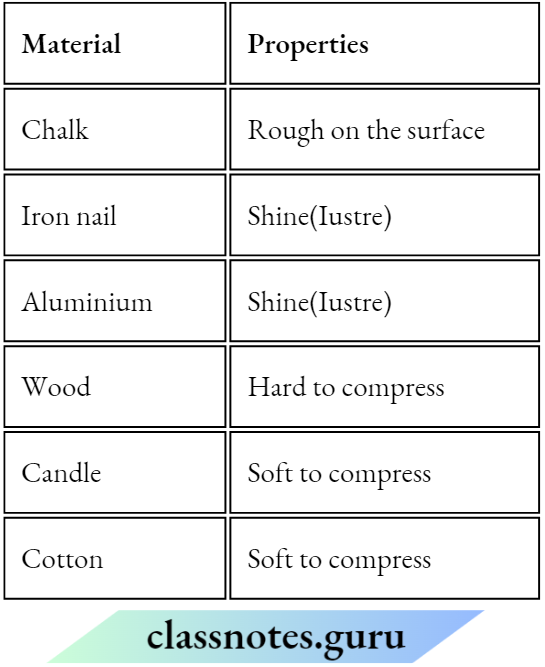
Question 2. Sugar, salt, mustard oil, sand, sawdust, honey, chalk powder, petals of flowers, soil, copper sulphate crystals, glucose, and wheat flour are some substances given to Paheli. She wants to know whether these substances are soluble in water or not. Help her in identifying soluble and insoluble substances in water.
Answer: Substances soluble in water are sugar, salt, honey, copper sulphate crystals, and glucose. Substances insoluble in water are mustard oil, sand, sawdust, chalk powder, petals of flowers, soil, and wheat Hour.
Read and Learn More Class 6 Science Question And Answers
Question 4. Why do you think oxygen dissolved in water is important for the survival of aquatic animals and plants?
Answer: Oxygen gas dissolves in water, i.e. oxygen gas is soluble in water. The plants and animals which live in water use the oxygen dissolved in water for respiration. Thus, oxygen gas dissolved in water is very important for the survival of animals and plants that live in water.

Question 5. Kavita bought new silver anklets. After a month, she found that the anklets had lost their lustre and turned black. She had doubts that they were not made up of pure silver. But her mother told her to wash it with lemon juice. She washed her silver anklets and found that the silver anklets had got the lustre back. Read the above passage and answer the following questions.
Answer:
1. Do you think that the anklets are not of pure silver?
Answer: No, the anklets were made up of pure silver.
2. Why silver anklets lose their lustre after some time?
Answer: Silver anklets lost their lustre and appear dull, because of the action of air and moisture On them
Question 6. Rohan and his friends planned to play a cricket match on Sunday morning. But, by chance on Saturday, Rohan got a high fever. Due to high fever, his parents did not allow him to play cricket. So, Rohan was very upset. But his father suggested to him that he could see the cricket match that his friends were playing in the park through a glass window, although the window would be closed. Read the above passage and answer the following questions.
Answer:
1. How Rohan was able to see the cricket match, although the window was closed?
Answer: Rohan was able to see the cricket match through
glass window panes which were transparent
2. Write different types of materials based on their transparency.
Answer: Based on transparency different types of materials are
- Transparent materials like glass, water air.
- Opaque materials like wood, cardboard, and metal containers.
- Translucent materials like oil paper, butter paper
Question 7.

Answer:
1. Why is Sachin not able to see through the wall?
- The wall is transparent
- The wall is translucent
- The wall is opaque
- The wall is reflective
Answer: 3. The wall is opaque
2. Name the device Sachin is using to see the tree on the other side of the wall.
- Microscope
- Periscopes
- Telescope
- Electroscope
Answer: 2. Periscopes
3. Can we use cardboard instead of a plane mirror in this device? Give a reason for your answer. are often used in national defence. Describe two possible uses of this device by the military.
Answer: No, cardboard cannot be used as it does not have a shiny surface. Hence, it reflects only a small amount of light.
4. Periscopes are often used in national defence. Describe two possible uses of this device by the military.
Answer:
- Perioscopes are used in submarines.
- Soldiers use them to spot enemies in trenches.
Question 8. Namita has three boxes with the same thickness. She places a burning candle inside each box. The images show how Namita was able to view the candle through each box.

Answer:
1. Which box is made of an opaque material?
Answer: Box 3 is made up of an opaque material as the candle is not visible
2. Namita replaced box 1 with a thicker box made of the same material and repeated the activity. Will there be any change in the results of the activity? Explain your answer.
Answer: With the increase in thickness, the candle will not be visible.
Question 9. Aqeel poured liquid 1 and liquid 2, each into a jar of water. He stirred the mixture in each jar with a spoon. He allowed the mixtures to rest for 10 mins.
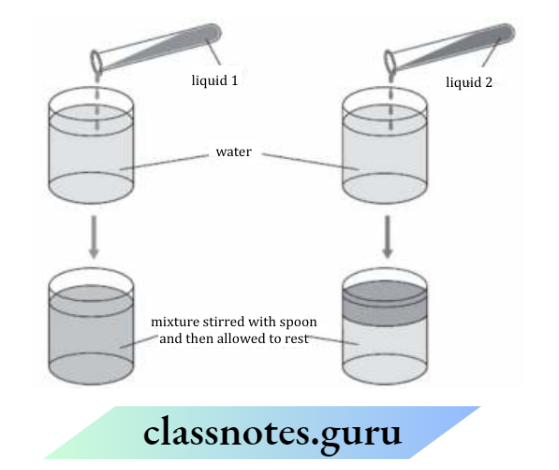
Which of the following must Aqeel keep the same in his activity? Circle ‘Yes’ or ‘No’ for the correct response

Are liquids and 2 soluble in water? Write Yes or No in the space given in the table below.

Answer:
- Yes, Yes, No
- Yes, No
Question 10. Name five objects which can be made from wood.
Answer: Five objects which can be made from wood are
- Door
- Window
- Chair
- Table
- Boat
Question 12. Select those objects from the following that shine: Glass bowl, plastic toy, steel spoon, cotton shirt
Answer: Among the given objects, glass bowls and steel spoons are shiny objects which are also called lustrous materials.
Question 13. Match the objects given below with the materials from which they could be made. Remember, an object could be made from more than one material and a given material could be used for making many objects.
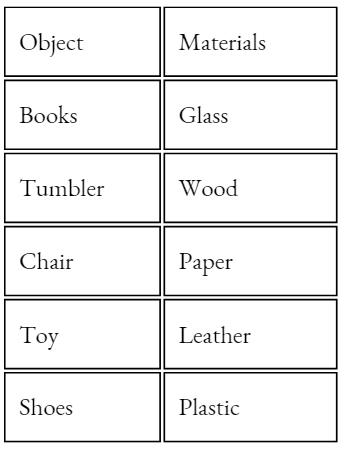
Answer: The correct table is shown below
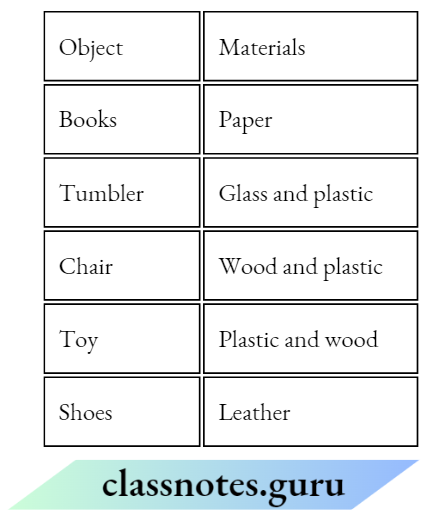
Question 14. State whether the statements given below are True or False.
- Stone is transparent, while glass is opaque.
- A notebook has lustre, while an eraser does not.
- Chalk dissolves in water.
- A piece of wood floats on water.
- Sugar does not dissolve in water.
- Oil mixes with water.
- Sand settles down in the water.
- Vinegar dissolves in water
Answer:
- False, glass is transparent because it allows light to pass through it while stone is opaque because it does not allow light to pass through it.
- False, notebook and eraser do not have any lustre.
- False, chalk is insoluble in water.
- True
- False, sugar dissolves in water.
- False, oil does not mix with water it floats on water.
- True
- True
Question 15. Below are the names of some objects and materials: Water, basketball, orange, sugar, globe, apple and earthen pitcher. Group them as
- Round shaped and other shapes.
- Eatables and non-eatables.
Answer: Objects or materials which are in the form of circles, are known as round shaped.
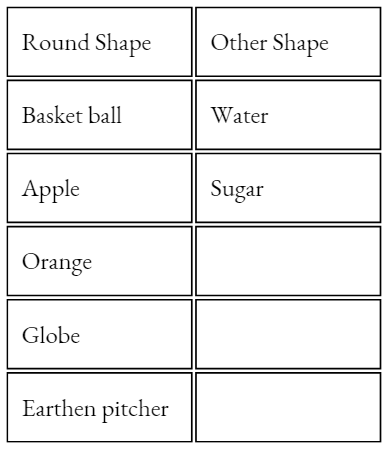
The substances which we can eat, are known as eatables otherwise it is known as non-eatables
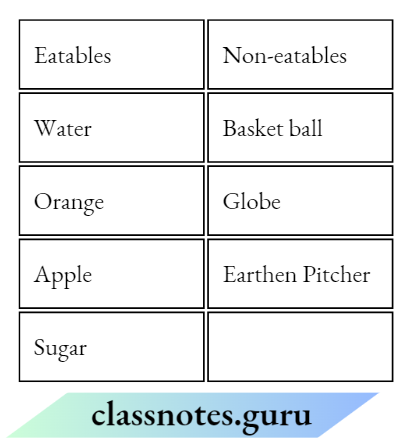
Question 16. List all items known to you that float on water. Check and see if they will float on oil or kerosene.
Answer:
A list of some items that float on water are
- Wood
- Wax
- Thermocol
- Oil
- Ice
- Plastic
A list of items that float on oil or kerosene are
- Wood
- Paper
- Wax
- Plastic
- Thermocol
Question 17. Find the odd one out from the following
- Chair, Bed, Table, Baby, Cupboard
- Rose, Jasmine, Boat, Marigold, Lotus
- Aluminium, Iron, Copper, Silver, Sand
- Sugar, Salt, Sand, Copper sulphate
Answer:
- Except baby, all others are non-living things.
- Except for the boat, all others are flowers.
- Except for sand, all others are metals.
- Except for sand, all others are soluble in water.
NCERT Class 6 Science Chapter 2 Sorting Materials Into Groups Short Question And Answers
Question 1. Give three common characteristics of materials.
Answer: The three common characteristics of materials
- All materials occupy space.
- All materials possess mass.
- All materials can be felt by one or more of our sense organs.
Question 2. Give the name of two objects for each which can be made from the following materials
- Glass
- Iron
- Gold
- Aluminium
Answer:
- Glass Window pane, tumbler.
- Iron Rods, iron nails
- Gold Jewellery, coins.
- Aluminium Aeroplane, window frames.
Question 3. List some materials that are used for making more than one type of object.
Answer: List of some materials that are used for making more than one type of an object as follows
Wood chair, table, plough, bullock cart and its wheels. Paper books, notebooks, newspapers, toys, calendars. Leather shoes, belts, wallets, bags and photo albums. Plastic buckets, lunch boxes, toys and pipes.
Question 4. Why paper-like materials are not used for cooking vessels?
Answer: Cooking vessels are made of a material with a high burning point but paper catches fire easily. Hence, it would not be wise to use paper-like materials for cooking vessels.
Question 5. Why are different materials used for making different objects?
Answer: Different materials have different properties. Materials are chosen to make objects depending on their properties and the purpose for which the object is to be used.
Question 6. Why are handles of utensils made from wood or plastic?
Answer: The handles of utensils are made from wood or plastics because these materials do not heat us easily unlike iron, aluminium, etc. and our hands do not burn while handling these utensils when they are hot.
Question 7. It was Paheli’s birthday. Her grandmother gave her two gifts made up of metals, one old dull silver spoon and a pair of lustrous gold earrings. She was surprised to see the difference in the appearance of the two metals. Can you explain the reason for this difference?
Answer: The silver spoon on long exposure to moist air has lost its shine and appears dull whereas gold does not tarnish.
Question 8. Which among the following materials would you identify as soft materials and why?
Ice, rubber band, leaf, eraser, pencil, pearl, a piece of wooden board, cooked rice, pulses and fresh chapati.
Answer: Materials which can be compressed or scratched easily – are called soft materials. Among the given materials rubber band, leaves, erasers, cooked rice and fresh chapati are soft materials because they can be compressed or scratched easily
Question 9. You are provided with the following materials: Turmeric, honey, mustard oil, water, glucose, rice flour, and groundnut oil. Make any three pairs of substances where one is soluble in the other and any three pairs of substances where one substance is insoluble in the other.
Answer: Soluble Substances
- Honey in water
- Groundnut oil in mustard oil
- Insoluble substances
- Turmeric in water
- Mustard oil in water
Question 10. Give two examples of gas which dissolve in water.
Answer: Two examples of gas that dissolve in water are as follows
- Oxygen gas dissolved in water is very important for the survival of animals and plants that live in water.
- Carbon dioxide also dissolves in water.
Question 11. Give five examples of each of the objects that float and sink in water.
Answer: Objects that float in water are plastic, sawdust, dry leaves, ice, and kerosene. Objects that sink in water are copper, silver, gold, stone, and chalk.
Question 12. Our palm is translucent. Explain with an activity.
Answer: Cover the glass of a torch with your palm in a dark area. Switch on the torch and observe from the other side of the palm. We see that the light of the torch passes through the palm, but not clearly. This demonstration shows that our palm shows the property of translucent when a strong beam oflight passes through it.
NCERT Class 6 Science Chapter 2 Sorting Materials Into Groups Very Short Answer Type Questions
Question 1. Write two things which are made from glass.
Answer: Bowls and mirrors are made from glass.
Question 2. Name two materials which appear shiny.
Answer: Aluminium and iron appear to shine
Question 3. Why does iron appear different from copper and aluminium?
Answer: Iron appears different from copper and aluminium because it reacts with air and moisture loses its shape and appears dull, but in the case of copper and aluminium, these maintain their shine.
Question 4. Give the reason why some metals become dull and lose their shine (lustre).
Answer: Some metals lose their shine because when exposed to air react with moisture and gases present in them, thereby forming a dull layer of some other compounds.
Question 5. By which property, do steel and sponge differ from each other?
Answer: Hardness and softness are the properties by which steel and sponge differ from each other.
Question 6. Mixtures of red chilli powder in water, butter in water, petrol in water and honey in water were given to Radha, Sudha, Sofia and Raveena, respectively. Whose mixture is in solution form?
Answer: Raveena has a solution because honey will dissolve in water whereas red chilli powder, butter and petrol float on water.
Question 7. Are vinegar and lemon juice soluble or insoluble in water?
Answer: Vinegar and lemon juice are completely soluble in water.
Question 8. Write two names of liquids which are insoluble in water.
Answer: Mustard oil and kerosene oil are the two liquids which are insoluble in water.
Question 9. Materials which are denser than water sinks in water. Give two examples of such materials.
Answer: Honey and a steel spoon are examples of materials which are denser than water. These will sink.
Question 10. Some materials float on water. Name two such materials.
Answer: Wood and plastic are the materials which float on water.
Question 11. Take a small cotton ball and place it in a tumbler/bowl filled with water. Observe it for at least 10 minutes. Will it float or sink in water and why?
Answer: Cotton ball initially floats on water, but after a few minutes (i.e. 10 min), it sinks because it absorbs water.
Question 12. Do all liquids dissolve in water?
Answer: Some liquids get completely dissolved in water. Some others do not dissolve in water and form a separate layer when kept aside for some time.
Question 13. Do all gases also dissolve in water?
Answer: Some gases dissolve in water whereas others are not. Water usually has small quantities of some gases dissolved in it, e.g. oxygen gas is dissolved in the water.
Question 14. List the following substances as soluble and insoluble in water. Sand, sugar, vinegar, common salt, chilli, ghee.
Answer:
- Soluble sugar, vinegar, common salt.
- Insoluble sand, chilli, ghee.
Question 15. Why a shopkeeper prefers to keep biscuits and sweets in a glass or plastic container?
Answer: Due to the transparent nature of glass or plastic containers, biscuits, sweets, etc. can be seen easily by buyers. Hence, shopkeepers store them this way.
Question 16. Write two objects through which things can be seen clearly.
Answer: Polythene and glass containers are transparent objects through which things can be seen clearly.
Question 17. On a bright sunny day, Shikha was playing hide and seek with her brother. She hides behind a glass door. Do you think her brother will be able to locate her? If yes, why? If not, why not? Competency Based Que.
Answer: Yes, her brother can easily locate her because the glass door is a transparent material.
Question 18. Write the name of two objects which are made from opaque materials.
Answer: Blackboard and wooden doors are objects which are made from opaque materials.
Question 19. Why do we need to group materials in everyday life?
Answer: We need to group materials for our convenience. Grouping materials helps us to locate things easily.
Question 20. Do liquids also dissolve in water?
Answer: No, all liquids do not dissolve in water. Liquids like vinegar, and lemon juice, dissolve in water, while most oils do not mix and form a separate layer.
Question 21. What happens when dried leaves, a piece of stone and a drop of honey are dropped in water?
Answer: Dried leaves float on the surface of water, while a piece of stone and honey sink to the bottom.
Question 22. Give five examples of each object that floats on water and those that sink in water.
Answer: Examples of objects that float on water are balloons, sponges, ice, empty bottles, boat, etc. Examples of objects that sink in water are stone, iron blocks, marble, honey, jewellery, etc.
Question 23. Give some examples of translucent materials.
Answer: Some examples of translucent materials include frosted glass, thin plastic sheets, wax paper, some fabrics, etc.
Question 24. Is the palm of our hand transparent, translucent or opaque?
Answer: The palm ofour hand is translucent. Hence, we can see some light coming through it
NCERT Class 6 Science Chapter 2 Sorting Materials Into Groups Fill In The Blanks
1. Materials through which we are not able to see are called Opaque materials.
2. Animals live underwater. It is because oxygen gas dissolves in it.
3. Rough Materials have uneven surfaces.
4. Rough materials have an uneven or irregular surface.
5. Materials which cannot be compressed are called Hard materials.
6. Soft materials can be cut with a knife.
7. Materials which do not disappear in water are called insoluble materials
8. Those materials through which we cannot see are called translucent materials.
NCERT Class 6 Science Chapter 2 Sorting Materials Into Groups Write True Or False
1. False Hard materials are easily compressible.
2. False Butter paper is a transparent material.
3. False Gold is not a lustrous material.
4. Diamond Is known as the hardest natural material. True
5. Ice Is lighter than water. True
6. Mustard oil Is soluble in water. False, mustard oil is insoluble in water
7. Carbon dioxide gas is soluble in water. False
8. Mirror is opaque. False
NCERT Class 6 Science Chapter 2 Sorting Materials Into Groups Assertion-Reason Question And Answers
The following questions consist of two statements. Assertion and Reason (R). Answer these questions by selecting the appropriate option given below.
- Both A and R are true and R is the correct explanation of A
- Both A and R are true, but, R is not the correct explanation of A
- A is true, but, R is false
- A is false, but, R is true
- Assertion Chalk powder floats on water.
Reason (R) Chalk powder is insoluble in water. - Assertion Animals can live underwater.
Reason (R) O2 dissolves in water. - Assertion Frying pan is translucent.
Reason (R) Translucent objects allow some light to pass through them. - Assertion Materials are grouped for convenience.
Reason (R) Materials can be grouped based on their names.
Answers
- A is false, but R is true. This can be corrected as Chalk powder is insoluble in water. It settles down at the bottom.
- Both A and R are true and R is the correct explanation of A.
- A is false, but R is true. This can be corrected as the Frying pan is made up of metal. Hence, it is opaque, opaque materials allow no light to pass through, while translucent materials allow some light.
- A is true, but R is false. R can be corrected as Materials are grouped based on their properties and not names.
NCERT Class 6 Science Chapter 2 Sorting Materials Into Groups Match The Columns
Question 1. Match the following columns

Answer: A-2, B-1, C-4, D-3
Question 2. Match Column 1 with Column 2.
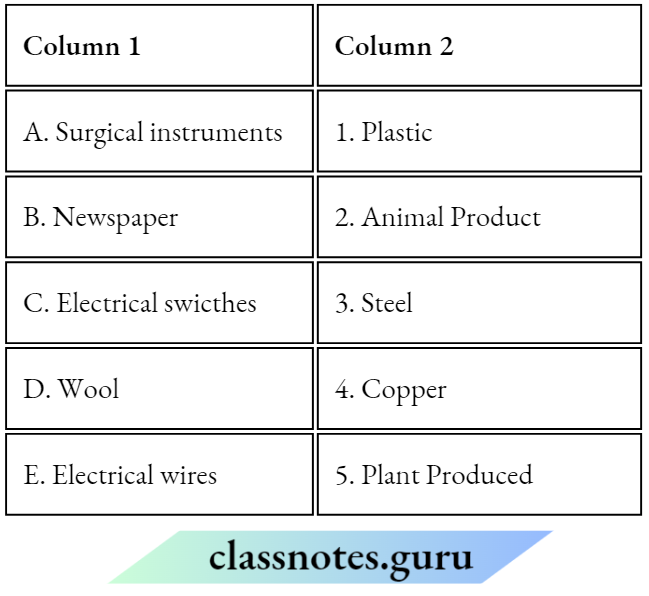
Answer: A— 3, B— 5, C— 1, D— 2, E— 4.
